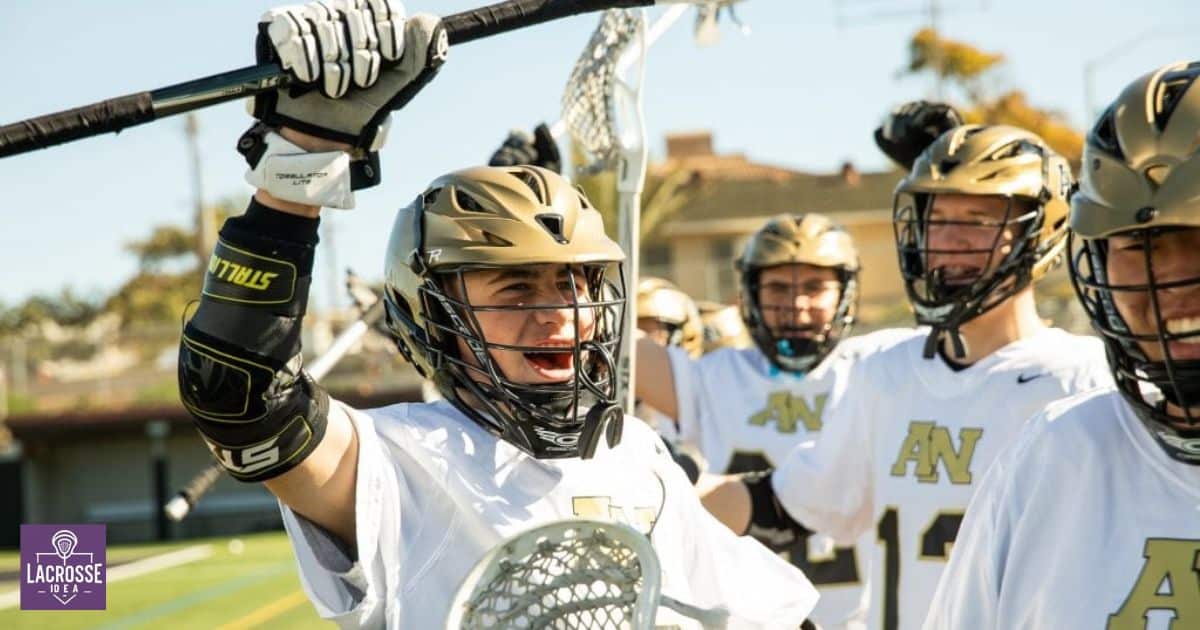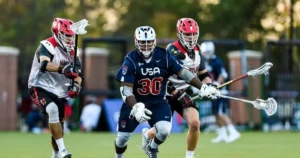Are you curious about how to play lacrosse? Look no further! In this article, we will guide you through the step-by-step process of playing this exciting sport. From understanding the object of the game to mastering the rules and techniques, we will provide you with all the information you need to become a skilled lacrosse player. Whether you are a beginner or looking to enhance your skills, this article is your pathway to belonging in the lacrosse community.
Key Takeaways
- Lacrosse is a game where the objective is to score more goals than the opposing team using a small rubber ball and a long-handled stick.
- Players must have the appropriate equipment such as a lacrosse stick, helmet, shoulder pads, arm guards, and gloves to ensure safety and effective gameplay.
- Scoring in lacrosse requires skill, strategy, and teamwork, with players needing to outmaneuver the opposing team’s defense and utilize stick-handling skills to maintain possession.
- Winning strategies in lacrosse include effective communication, tactical awareness, skillful execution, and mental resilience, which require planning, teamwork, skill execution, and staying focused and positive.
Object Of The Game
The primary objective of lacrosse is to score more goals than the opposing team by using a small rubber ball and a long-handled stick to propel the ball into the opponent’s net. This thrilling sport, steeped in Native American history, offers players a sense of belonging and camaraderie as they work together to achieve victory.
The object of the game is to outmaneuver the opposing team’s defense and strategically pass and shoot the ball into the net, showcasing skill, agility, and teamwork. Lacrosse provides players with a platform to showcase their abilities while also fostering a sense of community and connection. Whether playing at the amateur or professional level, the shared goal of scoring goals and winning matches unites lacrosse players, creating a strong sense of belonging within the sport.
Players And Equipment
Playing lacrosse requires players to have specific equipment and adhere to certain rules. To fully participate in the game, players need the following items:
- Lacrosse stick: This is the essential tool used for catching, passing, and shooting the ball. It consists of a shaft and a head with a pocket to hold the ball.
- Helmet: Safety is paramount in lacrosse, so players must wear a helmet that meets the required standards to protect their heads from potential injuries.
- Shoulder pads and arm guards: These protective gear pieces shield the upper body from checks and collisions during gameplay.
- Gloves: Designed to protect the hands and improve grip, lacrosse gloves are crucial for players to maintain control of the stick and handle the ball effectively.
Scoring
To successfully score in lacrosse, players must aim to shoot the ball into the opposing team’s goal. Scoring is a crucial aspect of the game that requires skill, strategy, and teamwork. The objective is to outmaneuver the opposing team’s defense and find an opening to take a shot. Players must be agile and quick, utilizing their stick-handling skills to maintain possession of the ball and create scoring opportunities.
Communication and coordination among teammates are essential to execute effective plays and confuse the opposing defense. Timing is crucial, as players must be ready to receive passes and make accurate shots on goal. Scoring not only contributes to the team’s success but also boosts morale and fosters a sense of belonging among players.
Winning The Game
How can a lacrosse team secure a victory? Winning a lacrosse game requires a combination of strategic planning, teamwork, skill execution, and mental fortitude. Here are four key elements to consider when aiming for success on the lacrosse field:
- Effective Communication: Clear and constant communication among team members is essential for coordinating plays, defending against opponents, and executing offensive strategies.
- Tactical Awareness: Understanding the game’s dynamics and being able to adapt to different situations is crucial. This includes recognizing and exploiting opponents’ weaknesses, as well as adjusting game plans as needed.
- Skillful Execution: Mastery of fundamental lacrosse skills, such as passing, shooting, catching, and ground ball pickups, is vital. Consistently executing these skills under pressure can give a team a competitive advantage.
- Mental Resilience: Maintaining focus, staying positive, and persevering through challenges are all qualities that contribute to success. A mentally resilient team can bounce back from setbacks and maintain composure during intense moments.
Rules Of Lacrosse
The rules of lacrosse involve a combination of physical contact and strategic gameplay. It is a fast-paced sport that requires skill, agility, and teamwork. One of the fundamental rules of lacrosse is that players must use a long-handled stick with a netted head to catch, carry, and pass the ball. The objective is to score goals by shooting the ball into the opponent’s net, while also preventing the opposing team from scoring.
However, there are certain restrictions and penalties to ensure fair play and player safety. These include rules regarding body checking, stick checks, offside violations, and penalties for unsportsmanlike conduct. Understanding and following these rules is crucial to playing lacrosse effectively and enjoying the game to its fullest. Now, let’s delve into what exactly lacrosse is and its rich history.
What Is Lacrosse?
Lacrosse, a dynamic sport rooted in Native American traditions, combines elements of teamwork, skill, and athleticism to create an exhilarating game. To truly understand what lacrosse is, consider the following:
- Rich History: Lacrosse has been played for centuries by Native American tribes, serving as not just a game but also a spiritual ritual.
- Fast-paced Gameplay: Lacrosse is known for its high-speed action, requiring players to think quickly and react swiftly to make strategic plays.
- Teamwork and Strategy: Lacrosse is a team sport that demands coordination and communication among players to achieve success.
- Physicality and Skill: Lacrosse requires a unique combination of physical strength, agility, hand-eye coordination, and stick-handling skills.
In essence, lacrosse encompasses the spirit of camaraderie, tradition, and athleticism, offering players a sense of belonging as they engage in this thrilling and culturally significant sport.
How To Play Lacrosse?
To begin learning how to play lacrosse, it is important to understand the basic rules and equipment required for this fast-paced and physically demanding sport. Lacrosse is played with a small rubber ball and long-handled sticks with a netted scoop at the end, called a crosse. The objective of the game is to score goals by shooting the ball into the opposing team’s net while also trying to prevent them from scoring.
Players must wear protective gear, including a helmet, shoulder pads, arm guards, gloves, and a mouthguard. Lacrosse combines elements of basketball, soccer, and hockey, making it a unique and exciting sport to play. Understanding these basic rules and equipment is essential for beginners to get started in the game. Now, let’s move on to the next section where we will explore the different parts of a lacrosse field and their significance.
Lacrosse Field Explained
The lacrosse field serves as the designated playing area for the game, providing players with defined boundaries and strategic positions for gameplay. To better understand the lacrosse field, here are four key aspects to consider:
- Field dimensions: A regulation lacrosse field measures 110 yards long and 60 yards wide. These dimensions ensure a balanced and competitive playing environment.
- Boundary lines: The field is marked with boundary lines, including the sidelines and end lines. These lines define the playing area and help maintain order during gameplay.
- Goal areas: At each end of the field, there is a goal area. This is where the goalkeepers defend the net and where offensive players attempt to score goals.
- Midfield line: The midfield line divides the field into two halves and is an important reference point for gameplay strategies.
Understanding the layout and components of the lacrosse field is crucial for players to effectively navigate the game. Now, let’s explore how long a lacrosse game typically lasts.
How Long Is A Lacrosse Game?
A lacrosse game typically lasts for a specified duration, determined by the level of play and the specific rules governing the game. The length of a lacrosse game can vary depending on whether it is played at the youth, high school, college, or professional level. To give you a better understanding, here is a breakdown of the average game durations for each level:
| Level | Game Duration |
|---|---|
| Youth | 48 minutes |
| High School | 48 minutes |
| College | 60 minutes |
| Professional | 60 minutes |
| International | 60 minutes |
It’s important to note that these durations may vary slightly depending on factors such as overtime or time-outs. However, this table provides a general idea of how long a lacrosse game typically lasts at each level.
How Many Players In Lacrosse?
In a lacrosse game, the number of players on each team is typically ten, consisting of three attackmen, three midfielders, three defensemen, and one goalie. This balanced distribution of players ensures strategic gameplay and allows for effective offensive and defensive tactics. Here is a breakdown of each player’s role on the lacrosse field:
- Attackmen: These players are responsible for scoring goals and creating opportunities for their team. They use their speed, agility, and stick skills to navigate the opponent’s defense and shoot accurately.
- Midfielders: Midfielders play both offense and defense and are crucial for transitioning the ball between the two ends of the field. They possess endurance, versatility, and strong ground ball skills.
- Defensemen: These players focus on preventing the opposing team from scoring. They use their physicality, positioning, and defensive techniques to disrupt the opponent’s offense and protect their own goal.
- Goalie: The goalie is the last line of defense. They are responsible for blocking shots and coordinating the defense. They possess quick reflexes, excellent hand-eye coordination, and strong communication skills.
Understanding the roles of each player is essential for a cohesive and successful lacrosse team.
How To Score In Lacrosse?
Scoring in lacrosse requires precise shooting and strategic positioning to outmaneuver the opposing team’s defense. To score a goal, players must aim accurately and generate enough power to beat the goalkeeper. One effective technique is the overhand shot, where the player releases the ball from above their shoulder, giving it extra speed and accuracy.
Another method is the sidearm shot, which involves a lower release point and can be more difficult for the goalkeeper to anticipate. Positioning is also crucial in scoring. Offensive players must constantly move and create opportunities by cutting to the goal or setting screens to confuse the defense. Additionally, teamwork and communication are essential for successful scoring plays, as players need to coordinate their movements and passes to create space and find open shooting opportunities.
Out Of Bounds Lacrosse Rules
When the ball goes out of bounds in lacrosse, certain rules come into play to determine possession and restart the game. Here are four key rules that apply in such situations:
- Sideline Out of Bounds: If the ball goes out of bounds along the sideline, possession is awarded to the team that did not touch it last. The opposing team must give the player with possession at least 5 yards of space to restart.
- Endline Out of Bounds: When the ball crosses the endline and goes out of bounds, possession is given to the team that did not touch it last. The player with possession restarts the game from the corner closest to where the ball went out.
- Loose Ball Out of Bounds: If the ball goes out of bounds but no team has clear possession, a loose ball push is awarded. The team that did not touch it last gets possession and restarts from the spot where the ball went out.
- Shot Out of Bounds: If a shot goes out of bounds, possession is awarded to the team whose player is closest to the ball when it goes out.
Understanding these out of bounds rules is crucial to maintaining fair play and determining possession in lacrosse.
With out of bounds rules covered, the next section will discuss stick check and body check lacrosse rules.
Stick Check And Body Check Lacrosse Rules
The stick check and body check lacrosse rules are essential components of the game’s regulations and ensure fair play and player safety. Stick checking involves using one’s stick to legally dislodge the ball from an opponent’s stick or prevent them from making a pass or shot. Players must aim for the opponent’s stick and avoid excessive force or hitting the opponent’s body.
Body checking, on the other hand, allows players to use their body to legally impede the progress of an opponent who has possession of the ball. However, body checks must be executed within the boundaries of the rules to prevent unnecessary injuries. These rules aim to strike a balance between physicality and safety, creating an environment where players can compete and belong while minimizing the risk of harm.
Lacrosse Fouls
Continuing from the previous subtopic, the rules of lacrosse include various fouls that players must avoid committing during gameplay. These fouls are enforced by the referees to maintain fairness and safety on the field. Here are four common lacrosse fouls that players should be aware of:
- Slashing: This occurs when a player uses their stick to hit an opponent’s body or stick excessively. It is important to use controlled stick checks to avoid this foul.
- Cross-checking: This foul happens when a player uses the shaft of their stick to forcefully check an opponent. Players should be cautious and use only legal body checks during gameplay.
- Tripping: Tripping an opponent, intentionally or unintentionally, is considered a foul. Players should be mindful of their movements and avoid actions that may cause an opponent to lose balance.
- Holding: Holding occurs when a player impedes the progress of an opponent by grabbing or restraining them. Players should focus on maintaining a fair and clean game by avoiding excessive physical contact.
Frequently Asked Questions
What Are the Different Positions in Lacrosse and What Are Their Specific Roles?
Lacrosse positions and their specific roles vary depending on the team’s strategy and formation. Some common positions include attack, midfield, defense, and goalie. Each position has unique responsibilities that contribute to the overall success of the team.
What Are Some Common Strategies and Tactics Used in Lacrosse?
Common strategies and tactics used in lacrosse include offensive plays such as the pick-and-roll, the give-and-go, and the fast break. Defensive tactics include zone defense, man-to-man marking, and double-teaming. These strategies aim to create scoring opportunities and prevent the opposing team from scoring.
Are There Any Specific Rules Regarding the Goalie’s Equipment and Role in the Game?
Regarding the goalie’s equipment and role in lacrosse, there are specific rules in place. The goalie must wear proper protective gear, including a helmet with a throat guard, a chest protector, gloves, and leg pads. They have the responsibility of defending the goal and preventing the opposing team from scoring.
Can You Explain the Face-Off Process and Its Importance in Lacrosse?
The face-off process in lacrosse is a critical aspect of the game, determining possession after goals and at the start of each quarter. It requires skill, speed, and strategy, with teams vying for control of the ball to gain an early advantage.
Are There Any Specific Rules or Guidelines for Substitutions and Player Rotations During a Lacrosse Game?
Substitutions and player rotations in lacrosse are regulated by specific rules and guidelines. These rules ensure fair play and maintain the integrity of the game. Coaches must adhere to the designated substitution protocols outlined by the governing lacrosse associations.
Conclusion
To conclude, mastering the game of lacrosse requires understanding the object of the game, the players and equipment involved, and the rules that govern it. By following step-by-step guidelines, players can learn how to score, navigate out of bounds situations, and adhere to stick and body check regulations. While keeping in mind the various fouls, players can enhance their skills in this thrilling sport.









